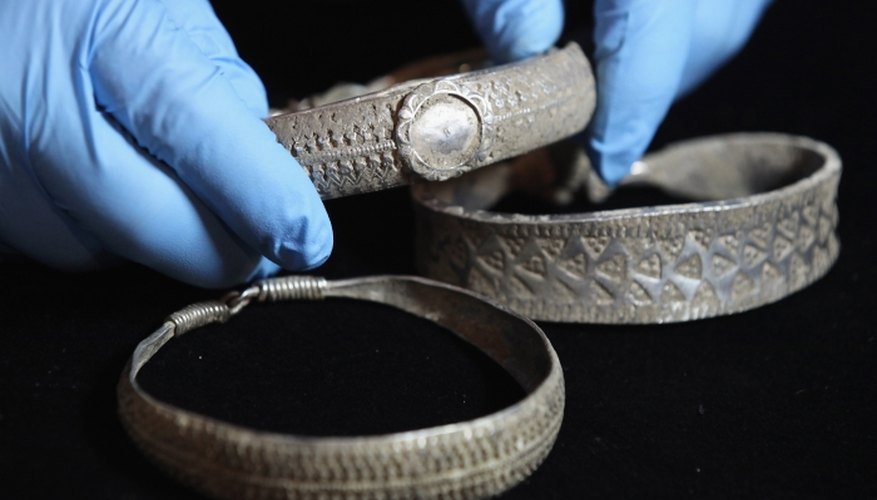The Vikings stem from Scandinavia, namely Norway, Sweden and Denmark. They invaded many countries like France, Great Britain and Russia and left traces of their culture wherever they went. Though thought of as barbarians, they were also traders and skilled craftsmen. Even though hygiene was a problem for the Vikings, they took much pride in how they presented themselves. Beautiful jewellery inspired by mythical beliefs was one of their trademarks.
Mythical background
Viking jewellery reflects this culture's strong belief in multiple gods, from whom they hoped to obtain strength, wisdom or luck. Odin, the main god of Norse mythology, was symbolised by a wolf or two ravens, which stood for thinking and remembering. He was said to be obsessed with knowledge. The guardian god Heimdall was believed to guard a bridge leading to Asgard, home of the gods, connecting the physical body with the spirit. He owned a horn to call forward Ragnarok, the end of the gods. Both objects appear on jewellery. Depictions of the goddess Freya wearing a necklace called Brisingamen promised success in love and beauty. Her animal symbol was a falcon. When the Norsemen settled in foreign countries, fertile ground and successful childbearing were a survival requirement. They had several fertility gods. Freyr, who is symbolised by a boar cast in gold, ensured success. The foot of the sea god Njord was also identified as a popular fertility symbol in Viking jewellery. Both symbols are of male origin, which implies the more important role of men in Viking culture.
- Viking jewellery reflects this culture's strong belief in multiple gods, from whom they hoped to obtain strength, wisdom or luck.
- Both symbols are of male origin, which implies the more important role of men in Viking culture.
Significance of jewellery in everyday life
Viking jewellery was mainly worn as a protective measure. The stories of the Norse gods inspired the meaning of each individual symbol. Jewellery also indicated prosperity and status within society. Gold and silver pieces were worn by those of great influence, while those of lesser standing wore bronze and pewter items. Viking jewellery was also used in trade for commodities.
- Viking jewellery was mainly worn as a protective measure.
Jewellery symbolism
Viking jewellery was usually worn for protection, and often reflected the traits of the many Scandinavian gods they believed in, mostly in the form of various animals. Besides wolves and ravens, Odin, the king of the Norse gods, was represented by snakes and drakes to bring good luck and provide strength. One of the most popular designs was Thor's hammer. Thor was the god of thunder and lightning. The tree Yggdrasil was believed to connect everything in the universe and was quite common as well. Viking jewellery was frequently influenced by other ancient cultures they encountered, especially the Celts. Hence, runes and Celtic knot designs show up quite often.
- Viking jewellery was usually worn for protection, and often reflected the traits of the many Scandinavian gods they believed in, mostly in the form of various animals.
- Besides wolves and ravens, Odin, the king of the Norse gods, was represented by snakes and drakes to bring good luck and provide strength.
Use of jewellery as currency
The Vikings used coins called pennies, halfpennies and farthings. They relied on the convenience of being able to cut down their silver to size for trades. Cut up pieces of jewellery often accompanied or substituted for pre-weighed silver, called "pennigar", in a deal. We know the currency type jewellery as "hack silver", as it was literally hacked down and weighed before trade took place. This broken up jewellery has been found in ancient stockpiles, along with coins.
- The Vikings used coins called pennies, halfpennies and farthings.
- Cut up pieces of jewellery often accompanied or substituted for pre-weighed silver, called "pennigar", in a deal.
Viking jewellery craftsmanship
A lot of Viking jewellery was fabricated by making a hand designing a wax form and pouring metal into it. The wax mould was broken once the metal had cooled, and the ornament buffed until it was shiny. This has been called the "lost wax" method. Vikings sometimes utilised punches to create simple patterns. The Danish Vikings often used the locally found amber gem stones to decorate their jewellery.
- A lot of Viking jewellery was fabricated by making a hand designing a wax form and pouring metal into it.
- The wax mould was broken once the metal had cooled, and the ornament buffed until it was shiny.
